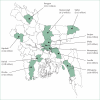Next generation maternal health: external shocks and health-system innovations
- PMID: 27642020
- PMCID: PMC5167371
- DOI: 10.1016/S0140-6736(16)31395-2
Next generation maternal health: external shocks and health-system innovations
Abstract
In this Series we document the substantial progress in the reduction of maternal mortality and discuss the current state of science in reducing maternal mortality. However, maternal health is also powerfully influenced by the structures and resources of societies, communities, and health systems. We discuss the shocks from outside of the field of maternal health that will influence maternal survival including economic growth in low-income and middle-income countries, urbanisation, and health crises due to disease outbreaks, extreme weather, and conflict. Policy and technological innovations, such as universal health coverage, behavioural economics, mobile health, and the data revolution, are changing health systems and ushering in new approaches to affect the health of mothers. Research and policy will need to reflect the changing maternal health landscape.
Copyright © 2016 Elsevier Ltd. All rights reserved.
Figures



Similar articles
-
Financing universal health coverage--effects of alternative tax structures on public health systems: cross-national modelling in 89 low-income and middle-income countries.Lancet. 2015 Jul 18;386(9990):274-80. doi: 10.1016/S0140-6736(15)60574-8. Epub 2015 May 14. Lancet. 2015. PMID: 25982041 Free PMC article.
-
Factors enabling comprehensive maternal health services in the benefits package of emerging financing schemes: A cross-sectional analysis from 1990 to 2014.PLoS One. 2018 Sep 25;13(9):e0201398. doi: 10.1371/journal.pone.0201398. eCollection 2018. PLoS One. 2018. PMID: 30252840 Free PMC article.
-
Financing universal health coverage: four steps to go from aspiration to action.Lancet. 2019 Sep 14;394(10202):902-903. doi: 10.1016/S0140-6736(19)32095-1. Lancet. 2019. PMID: 31526723 No abstract available.
-
Maternal and child health in Israel: building lives.Lancet. 2017 Jun 24;389(10088):2514-2530. doi: 10.1016/S0140-6736(17)30929-7. Epub 2017 May 8. Lancet. 2017. PMID: 28495101 Review.
-
Tracking development assistance for health and for COVID-19: a review of development assistance, government, out-of-pocket, and other private spending on health for 204 countries and territories, 1990-2050.Lancet. 2021 Oct 9;398(10308):1317-1343. doi: 10.1016/S0140-6736(21)01258-7. Epub 2021 Sep 22. Lancet. 2021. PMID: 34562388 Free PMC article. Review.
Cited by
-
Strengthening health system building blocks: configuring post-COVID-19 scenario in Pakistan.Prim Health Care Res Dev. 2021 Mar 25;22:e9. doi: 10.1017/S1463423621000128. Prim Health Care Res Dev. 2021. PMID: 33762035 Free PMC article. Review.
-
Does Combining Antenatal Care Visits at Health Posts and Health Centers Improve Antenatal Care Quality in Rural Ethiopia?Ethiop J Health Sci. 2023 Apr;33(Spec Iss 1):37-48. doi: 10.4314/ejhs.v33i1.5S. Ethiop J Health Sci. 2023. PMID: 38362475 Free PMC article.
-
Scaling up context-tailored clinical guidelines and training to improve childbirth care in urban, low-resource maternity units in Tanzania: A protocol for a stepped-wedged cluster randomized trial with embedded qualitative and economic analyses (The PartoMa Scale-Up Study).Glob Health Action. 2022 Dec 31;15(1):2034135. doi: 10.1080/16549716.2022.2034135. Glob Health Action. 2022. PMID: 35410590 Free PMC article.
-
Perspectives on barriers to traditional sources of sexual and reproductive health information and services: Are mHealth technologies the answer?Health Promot Perspect. 2024 Oct 31;14(3):258-267. doi: 10.34172/hpp.42607. eCollection 2024. Health Promot Perspect. 2024. PMID: 39633628 Free PMC article.
-
Determinants of Health Facility Utilization at Birth in South Sudan.Int J Environ Res Public Health. 2019 Jul 9;16(13):2445. doi: 10.3390/ijerph16132445. Int J Environ Res Public Health. 2019. PMID: 31324060 Free PMC article.
References
-
- Jamison DT, Summers LH, Alleyne G, et al. Global health 2035: a world converging within a generation. Lancet. 2013;382:1898–955. - PubMed
-
- Coady D, Parry I, Sears L, Shang B. How large are global energy subsidies? IMF Working Paper. International Monetary Fund; Washing DC: 2015.
-
- Jha P, Joseph R, Li D. Tobacco taxes: a win-win measure for fiscal space and health. Asian Development Bank; Mandaluyong City: 2012.
-
- Yamey G, Saxenian H, Hecht R, Sundewall J, Jamison D. Sweden's development assistance for health: policy options to support the Global Health 2035 goals. Expertgruppen for bistandsanalys; Stockholm: 2014.
-
- Thomas A. Do middle-income countries need aid? Literature review and analysis of evidence and opinions used in the aid differentiation debate. Bond for International Development; London: 2013.
Publication types
MeSH terms
Grants and funding
LinkOut - more resources
Full Text Sources
Other Literature Sources

